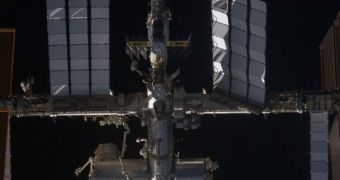The last array of solar panels has been finally deployed on the International Space Station yesterday, thus completing more than a decade of construction efforts. The new wings bring the lab to its full electricity-generating potential, and the station is now completely able to support a permanent six-member crew for long-term missions. The power output has been boosted by some 25 percent with yesterday's deployment, which has taken little over 2 hours, and everyone on the ISS, the Discovery shuttle, and at the flight control center have been relieved to see them unfurled and looking good.
There has been some tension during the proceedings, simply because the last time when an astronaut team deployed a solar panel array, one of them got caught in a wire and tore, and emergency repairs had to be conducted in a spacewalk. But it would seem that the new deployment has gone without a hitch, and Discovery commander Lee Archambault has radioed to Earth that everything is in order and looking good. The wings have unfurled automatically, and the entire sequence has been commanded from inside the ISS.
“Tremendous news! Great work guys. You've got a whole bunch of happy people down here as well,” the reply came quickly from the Mission Control. “We're very happy as well. Full power!” Archambault said as well. It's no easy task to deploy 115-foot (35-meter) -long solar panels in the hostile environment of space without something going amiss, especially considering that the station had to leave it's optimum orbit around the planet, in order to expose the new arrays to direct sunlight and heat them.
During certain moments of the mission, the communication between the 10 astronauts in orbit and the mission command has been impossible, but fortunately nothing has gone wrong during these minutes. “We were literally on pins and needles. It was just really like a great weight lifted,” Kwatsi Alibaruho, the station flight director, told reporters on Friday, after the $298-million arrays were deemed successfully deployed.
Today, astronauts from the Discovery and the ISS will perform the second scheduled spacewalk of their mission, as they will attempt to upgrade several key systems on the exterior walls of the lab. Originally, there were four excursions planned for the STS-119 mission, but due to significant, month-long delays, one of them had to be removed. Discovery will return to Earth on March 28th, although there is a possibility that it will arrive a day earlier. It brings back NASA astronaut Sandra Magnus, who has been replaced by JAXA expert Koichi Wakata.

 14 DAY TRIAL //
14 DAY TRIAL //